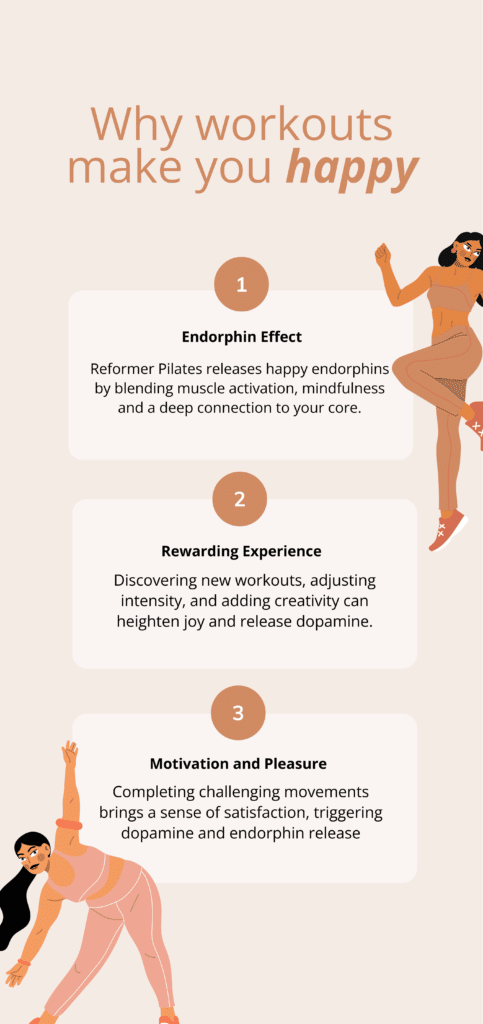Have you ever noticed that after a good workout, you feel a sense of euphoria and well-being? That post-exercise glow isn’t just a coincidence—it’s the magic of endorphins at work. Let’s explore the fascinating science behind why workouts make you happy — plus, how to release endorphins and dopamine.

The Science of Joy: Endorphins and Dopamine
The Endorphin Effect
The “Endorphin Effect” occurs when the body releases neurotransmitters called endorphins during physical activity. Produced by the brain and pituitary gland in response to stress or pain, endorphins act as natural pain relievers and mood enhancers. These molecules bind to specific receptors in the brain, triggering feelings of euphoria and well-being, commonly known as a “natural high” or “runner’s high.” It serves as a powerful motivator for regular physical activity, offering immediate rewards and long-term benefits for mental health. This is why workouts make you happy.
Did you know? Plenty of everyday activities can release endorphins without you even realising. For example, if you eat spicy food, get a massage or spend time laughing with friends, you’ll naturally increase your endorphin levels for a short amount of time. These are all natural stress relievers that can have a small but impactful effect on your mood.
Dopamine the Reward Molecule
Dopamine, known as the “reward molecule,” is vital for exercise. During physical activity, the brain chemical dopamine is released, creating feelings of pleasure and reinforcing the behaviour of exercise. This dopamine response enhances enjoyment and motivation during workouts and can lead to long-term changes in the brain’s reward system, promoting continued engagement in exercise and improving overall well-being. Dopamine production can naturally incentivise you to keep up your workout routine, so it’s a great tool to build better habits over time.
How To Release Endorphins and Dopamine
Exercise releases endorphins and dopamine through a complex series of physiological responses that occur within the body during physical activity. Here’s a breakdown of why exercise leads to the release of these neurotransmitters:
Stress Response
When you exercise, your bodies perceive physical exertion as a form of stress. In response to this stress, the brain releases endorphins, which act as natural painkillers and mood elevators. This is why mild to moderate exercise can work as a form of stress relief (and even pain relief in some cases) for so many people.
Tip: Mild to moderate exercise can be helpful for small pains like body aches, but it might nit be the best pain management technique for your body. While releasing endorphins can help relieve physical pain, it’s important to avoid overdoing it during your workouts. How much exercise is too much will depend on your body, but always be aware of any pain signals when exercising. A strong endorphin release can sometimes cause us to overdo it, leaving you worse for wear once the endorphin rush is over!
Rewards System Activation
Dopamine is often referred to as the “feel-good” neurotransmitter because it plays a central role in the brain’s reward system. When you engage in activities that are pleasurable or rewarding, such as exercise, dopamine is released, reinforcing the behaviour and motivating us to repeat it.
Motivation and Pleasure
Dopamine helps us experience feelings of pleasure and satisfaction, making us more likely to seek out activities that bring us joy and fulfilment. In the context of exercise, dopamine release serves as a built-in reward mechanism, encouraging us to maintain a regular workout routine.
How to Release Endorphins
Reformer Pilates, like other forms of exercise, has the potential to release endorphins and contribute to an overall sense of well-being. Reformer Pilates can facilitate the release of endorphins through a combination of muscle activation, mindfulness and core engagement.
Muscle Activation
Reformer Pilates involves controlled movements and resistance training that engage various muscle groups throughout the body. As muscles contract and stretch during exercises, they stimulate the release of endorphins to help alleviate discomfort and promote a sense of well-being.
Core Activation
Many Reformer Pilates exercises specifically target the core muscles, including the abdominals, back, and pelvic floor. Strengthening and stabilising the core not only improves posture and body alignment but also activates deep muscle fibres that can stimulate the release of endorphins.
How to Release Dopamine
Reformer Pilates can also contribute to the release of dopamine thanks to the nature of the workout leaving you with a sense of achievement.
Variety and Novelty
Reformer Pilates workouts involve a lot of variety and novelty which can be stimulating for the brain. Trying new exercises, varying the intensity, or incorporating creative movement patterns can enhance the experience and trigger dopamine release, especially when the brain encounters something novel and rewarding.
Rewarding Experience
The practice of Reformer Pilates can be inherently rewarding, especially as individuals progress and master different exercises. The sense of accomplishment and satisfaction that comes from completing challenging movements may stimulate the release of dopamine, reinforcing the positive experience.
Boost your happiness with Pilates
Exercise triggers the release of endorphins and dopamine, enhancing our mood and motivation. The intensity and novelty of exercise influence the magnitude of neurotransmitter release, contributing to feelings of euphoria and excitement. These physiological responses underscore the profound impact of exercise on our mood, motivation, and overall well-being.
Ready to see how Muse can be your go-to happy workout? Sign up to our exclusive Intro Offer for just $49 here!

